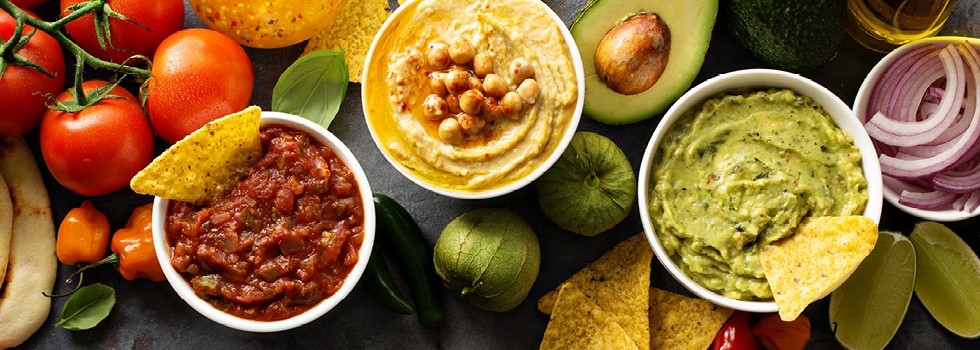Promotional Features
Premium Taste, Without the Premium: How Flavor Technology is Adding Value to Dips & Sauces
Next time you’re enjoying a barbecue, pool party or other gathering this summer, take a close look at the appetizers and foods being served. Whether it’s a creamy ranch veggie dip, a caramelized onion hummus, or a range of sweet and savory sauces and condiments for burgers and hot dogs – there’s a good chance that dips & sauces have a big presence, and flavors are a major focus. When it comes to getting consumers excited about flavors and trying new foods, no category is more effective than dips & sauces.
Commonly seen as a relatively inexpensive way to add robust flavor profiles to everyday dishes, dips & sauces serve as a gateway to encouraging new product trial and adoption – drawing in consumers who are interested in exploring exciting new flavors. The category also has a broad appeal with nearly 94% of all U.S. adults enjoying dips and sauces, and rich flavor innovation is at the heart of this growing category. More than 52% of consumers in a recent Mintel survey cited interest in trying new flavors in dips/sauces, and the category continues to grow after building momentum during the pandemic. According to Grandview Research, the dips category is expected to be among the fastest growing, with a global CAGR of 5.2% through 2025. Whether it’s salsa, dressings, condiments, guacamole, hummus, or anything in-between – dips and sauces can elevate traditional dishes and even invigorate otherwise mundane foods with an approachable burst of rich flavor.
Leveraging Technology for Exciting Flavors
Across all food & beverage categories, the past two years have consistently shown the trend of consumers turning to flavors as a source of excitement and adventure during the pandemic – and much of this discovery is happening right in the home kitchen. Dips and sauces have played a large role in making at-home cooking more creative and enjoyable, as they allow burgeoning chefs to easily add vivid flavor to familiar dishes and build on classic entrees. The major shift to consumers working from home also put added emphasis on lunch and snack dayparts – sparking a period of product development focusing on bold flavored sauces intended for cooking, at-home meal preparation and snacking.
As demand for bolder tasting dips and sauces grows, the flavor industry is responding with increasingly sophisticated technology aimed at delivering an intense flavor. New technology is being leveraged that amplifies the natural flavors in sauce and dip ingredients, producing clean-label products that deliver on the taste that consumers demand.
One of the world’s top flavor manufacturers is on a mission to reinvigorate the dips and sauces category with bold, high-quality flavors developed through advanced technology. California-based T. Hasegawa USA recently introduced several new technologies aimed at improving the flavor and taste experience of dips, sauces, dressings, marinades, condiments and more. Many of these technologies focus not only on producing a complex flavor profile, but also delivering the ultimate taste experience, including kokumi (Japanese for “Rich Taste”), which gives dips and sauces a full-bodied mouthfeel.
Many products in the dips and sauces category are dairy based, which provides a rich enjoyable creamy flavor profile. But as consumers demand more plant-based dairy alternatives, the industry is responding with technology aimed at naturally replicating the richness that whole milk or cream provides, without the use of dairy products or costly edible oils.
Recently, T. Hasegawa introduced an all-natural, plant-based EMULSITRACTTM milk colloid emulsion to the North American market. This advanced fat mimetic technology provides an effective solution for food and beverage brands that need to simulate the creaminess and rich mouthfeel of traditional whole milk in a wide range of products, including dips, sauces, dressings, condiments and more.
“Like many other food and beverage categories, dips and sauces often rely on the rich mouthfeel that traditional whole milk fat provides, but these products need to evolve to fit consumer demands,” explained T. Hasegawa’s VP of research & development, Jim Yang. “With the recent shift in demand for dairy-free products, and the rising cost of palm oil and other edible oils, Emulsitract offers a clean-label, natural solution that still delivers the creamy richness that consumers expect in these foods.”
The introduction of Emulsitract marks the latest in T. Hasegawa’s growing line of proprietary technologies aimed at providing a rich, full-bodied taste experience. Last year, the company introduced BOOSTRACTTM to the North American market, which is a Maillard Reaction-based flavor modifier that adds or enhances the effect of kokumi in foods and beverages.
Tapping into International Flavors
With borders closed and international travel nearly stopped for a long period during the pandemic, it’s no surprise that consumers turned to international food & beverage flavors as a source of excitement and escape over the past two years. Much of the world’s foods have a heavy emphasis on sauces and dips, and these compelling flavors are often the pathway to trial for many consumers. More than 40% of consumers like dips and sauces with international flavors, and since dips and sauces can be served on the side in light or heavy quantities, they offer a more customized, approachable form of trying new cuisines. International flavors are especially popular among female consumers. According to Mintel research1, women over-index in their interest in mainstream international cuisine, such as Mexican, Italian and Chinese. This presents a unique opportunity for food brands to customize dips and sauces that tap into these global favorites and appeal to women.
Part of the shift toward international flavors has been a focus on spicy foods, and consumers apparently can’t get enough high-heat sauces and dips. In fact, the total market for hot sauce in North America is currently over $1.13 Billion with a CAGR of 7.1% through 2028. The U.S. and Canada account for more than 40% of the global chili hot sauce market, showing impressive demand and future growth of this category3. As consumer tastes shift toward increasingly hotter menu items, brands are seeking creative ingredients and flavors sourced from Asian cuisine to deliver on the demand for fiery foods.
Leading the charge is sriracha – America’s favorite high-heat ‘rooster’ sauce. This beloved hot chili sauce exploded in popularity a few years ago, quickly growing from a staple in Thai and Vietnamese restaurants to a mainstream flavor in a broad range of products across North American menus and store shelves, and even a pop culture phenomenon enjoyed by millions of people around the world. The foundation of sriracha’s distinctive fiery flavor is its chili pepper base, which is added to vinegar, sugar and salt then fermented over time to produce the distinct taste that consumers demand.
“The success of sriracha is proof that a bold, spicy flavor – delivered in a simple tableside sauce – is able to elevate a wide variety of foods, elevating its popularity from Asian restaurants to a staple in home kitchens everywhere,” explained Jeanene Martinez, T. Hasegawa’s director of applications. “We’re continually exploring unique ingredients that can expand the applications of sauces and offer consumers an accessible way to add exciting flavor to meals.”
The rise of sriracha has opened the door for other international sauces focused on high-heat flavors, especially those from Asian countries such as Korea. One such example of a fermented hot sauce from Korean peninsula is Gochujang – a thick fermented red pepper paste that is growing in popularity as the “next Sriracha,” adding a sweet and spicy kick to sauces, marinades and more. Gochujang is the basis for the popular marinated beef dish Bulgogi (translating literally to “fire meat”), which is increasingly becoming a mainstream dish in U.S. restaurants – driven largely by demand from younger Gen-Z and Millennial consumers. Future flavors with directional growth from Korea include ganjang, jeotgal and makgeolli, which could lead to exciting new possibilities in dips, dressings and marinades.
Despite the notable rise in demand for spicy foods over the past couple years, American consumers in general still prefer mild heat. When asked about their preferred spice levels in dips, over 43% of U.S. consumers chose medium1, but this preference appears to be changing as younger consumers’ palates become more accustomed to higher heat. Consumers in a 2022 Mintel survey indicated their spice tolerance has gone up during the pandemic, especially among Gen-Z, Millennials and other younger consumers. Food brands can capitalize on these growth opportunities for extreme dip and sauce flavors with higher heat levels, to appeal to the rising generations of consumers.
Dips & Sauces in a Post-Pandemic Market
As life returns to normalcy from the interruptions of the pandemic, the dips and sauces category is evolving. According to Mintel research, most 2021 dip and sauce segment sales are now stabilizing higher than pre-pandemic levels, suggesting that these products have become a more routine part of consumer’s mealtimes. The culinary skills that consumers picked up during the pandemic are unlikely to go away now that restaurants are busier than they’ve been in years and tastes have changed over the past two years to include a variety of new flavors. As more workers are headed back to physical offices across the country, there is an increased focus on new product development for single-serve dips and healthier snacks. Consumers are seeking portion-controlled and portable snacks, and much of the innovation in this trend is driven by packaging innovations, such as dual-compartments that allow for a base dip like Greek yogurt to be joined by sweet or savory mix-ins that deliver exciting flavor combinations.
While the threat of rising supply costs and inflation are a factor in product development across all categories, food brands can rely on dips and sauces as a relatively inexpensive way to offer a creative flavor experience to consumers, no matter the economic climate.
Food and beverage brands who are looking to take their dips & sauces product development to the next level of flavor can explore the possibilities by contacting T. Hasegawa USA at www.thasegawa.com or by calling (866) 965-0502.







